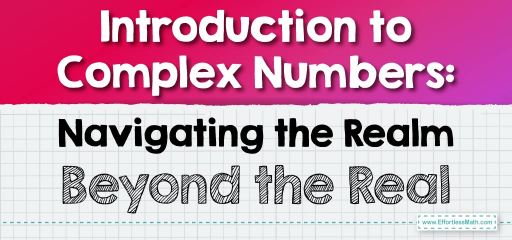Introduction to Complex Numbers: Navigating the Realm Beyond the Real
In mathematics, numbers have always been our trusty companions, helping us quantify and understand the world around us. While we are familiar with the ordinary numbers that measure, count, and calculate our daily lives, there exists a more mysterious and intriguing family of numbers: the complex numbers. Delving beyond the real number line, we enter a dimension where numbers have both magnitude and direction, real and imaginary components. This guide will escort you through the fascinating journey of complex numbers, from their inception to their multifaceted applications.

Step-by-step Guide to an Introduction to Complex Numbers
Here is a step-by-step guide to an introduction to complex numbers:
Step 1: Grounding in Real Numbers
- Understanding Real Numbers: Real numbers are all the numbers you’ve typically dealt with since early education. They can be positive, negative, zero, fractions, and irrational numbers (like \(π\)).
Step 2: The Dilemma of the Square Root of Negative One
- Positive Squares: Any non-negative real number (e.g., \(4\)) has a real square root (e.g., \(2\)).
- Negative Squares Problem: No real number multiplied by itself gives a negative result. This means that the square root of a negative number doesn’t have a real solution. What is the square root of \(-1\)? Enter the world of imaginary numbers.
Step 3: Birth of Imaginary Numbers
- Defining the Imaginary Unit: By convention, the square root of \(-1\) is represented by the symbol ‘\(i\)‘ and is termed as the ‘imaginary unit’. Thus: \(i^2=−1\)
- Expanding on Imaginary Numbers: Any real number multiplied by \(i\) becomes an imaginary number. For instance: \(3i,−7i,πi\) are all imaginary numbers.
Step 4: Merging Real with Imaginary – The Complex Numbers
- Definition: A complex number is a number that has both a real part and an imaginary part. It is usually represented in the form: \(a+bi\), where ‘\(a\)’ is the real part, ‘\(b\)’ is the coefficient of the imaginary part, and ‘\(i\)’ is the imaginary unit.
- Visualization: Think of complex numbers as points on a \(2D\) plane called the complex plane. The \(x\)-axis (horizontal) represents the real part, and the \(y\)-axis (vertical) represents the imaginary part.
Step 5: Arithmetic with Complex Numbers
- Addition and Subtraction: Just like binomials. Add/subtract the real parts together and the imaginary parts together.Example: \((3+4i)+(2−5i)=5−i\)
- Multiplication: Use the distributive property, keeping in mind that \(i^2=−1\).Example: \((3+4i)×(2−5i)=6−15i+8i−20i^2=6−7i+20=26−7i\)
Step 6: The Complex Conjugate & Division
- Complex Conjugate: If you have a complex number \(a+bi\), its complex conjugate is \(a−bi\).
- Purpose of the Conjugate: Multiplying a complex number by its conjugate gives a real number. This technique is particularly useful when dividing complex numbers.
Step 7: Magnitude and Angle
- Magnitude (or Modulus): The distance of the complex number from the origin in the complex plane. For a complex number \(a+bi\), its magnitude is: ∣\(a+bi\)∣\(=\sqrt{a^2+b^2}\)
- Angle (or Argument): The angle the line connecting the complex number to the origin makes with the positive \(x\)-axis. This is often represented in radians.
Step 8: Euler’s Formula & Complex Numbers
- Connecting Exponentials and Trigonometry: Euler’s formula is a deep connection between complex numbers, exponentiation, and trigonometry. It states: \(e^{ix}=cos(x)+isin(x)\)
Step 9: Applications of Complex Numbers
- Electrical Engineering: Used in analyzing alternating current circuits.
- Fluid Dynamics: Helps in understanding how fluids move.
- Quantum Mechanics: Fundamental in representing quantum states.
Final Word:
Complex numbers, though initially perplexing, unfold a universe of mathematical beauty and symmetry. They bridge gaps in our understanding and provide solutions where real numbers fall short. Whether you’re an aspiring mathematician, an engineer, or merely a curious soul, recognizing the elegance of complex numbers is acknowledging the depth and richness of the mathematical world. As you continue your numerical explorations, let the knowledge of complex numbers be a testament to the endless wonders and possibilities that mathematics has to offer.
Examples:
Example 1:
Determine which of the following numbers are complex or real: \(7i, -3\), and \(1+2i\).
Solution:
- \(7i\): This number has only an imaginary component and no real part. Thus, it’s a complex number.
- \(-3\): This number has no imaginary component; it’s purely real. Thus, it’s a real number.
- \(1+2i\): This number has both real and imaginary components. Thus, it’s a complex number.
Example 2:
Determine which of the following numbers are complex or real: \(0, 4-5i\), and \(6i\).
Solution:
- \(0\): Zero is a real number. Thus, it’s a real number.
- \(4-5i\): This number has both real and imaginary components. Thus, it’s a complex number.
- \(6i\): This number has only an imaginary component and no real part. Thus, it’s a complex number.
Related to This Article
More math articles
- 6th Grade Georgia Milestones Assessment System Math FREE Sample Practice Questions
- How to Solve Trig Ratios of General Angles? (+FREE Worksheet!)
- How to Prepare for the CLEP College Mathematics Test?
- Full-Length 7th Grade MCAS Math Practice Test
- Solve Equations
- Full-Length Accuplacer Math Practice Test
- 4th Grade RISE Math Worksheets: FREE & Printable
- 5th Grade PSSA Math Practice Test Questions
- The Best CHSPE Math Worksheets: FREE & Printable
- Top 10 HiSET Math Prep Books (Our 2023 Favorite Picks)









What people say about "Introduction to Complex Numbers: Navigating the Realm Beyond the Real - Effortless Math: We Help Students Learn to LOVE Mathematics"?
No one replied yet.